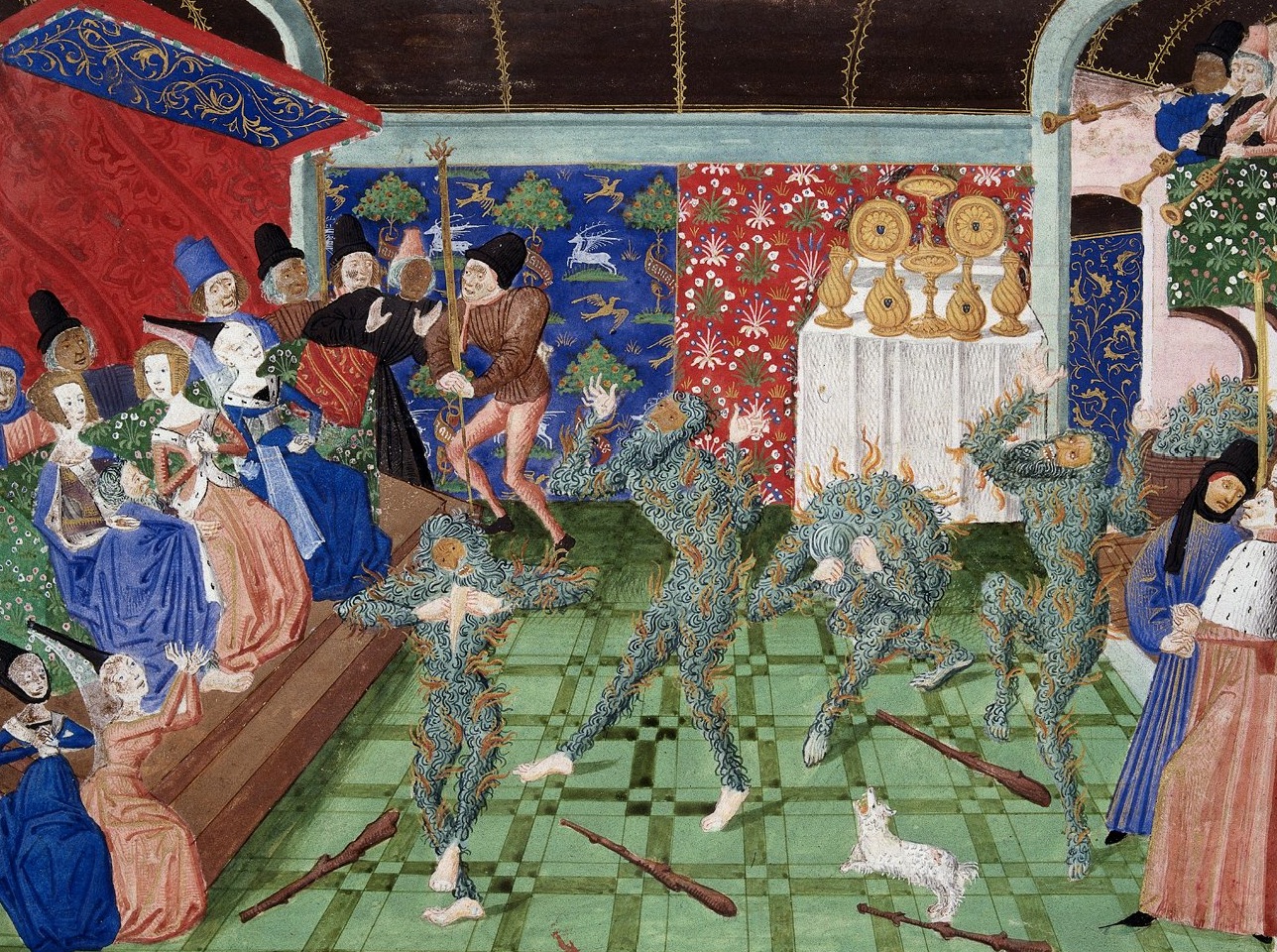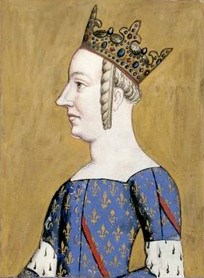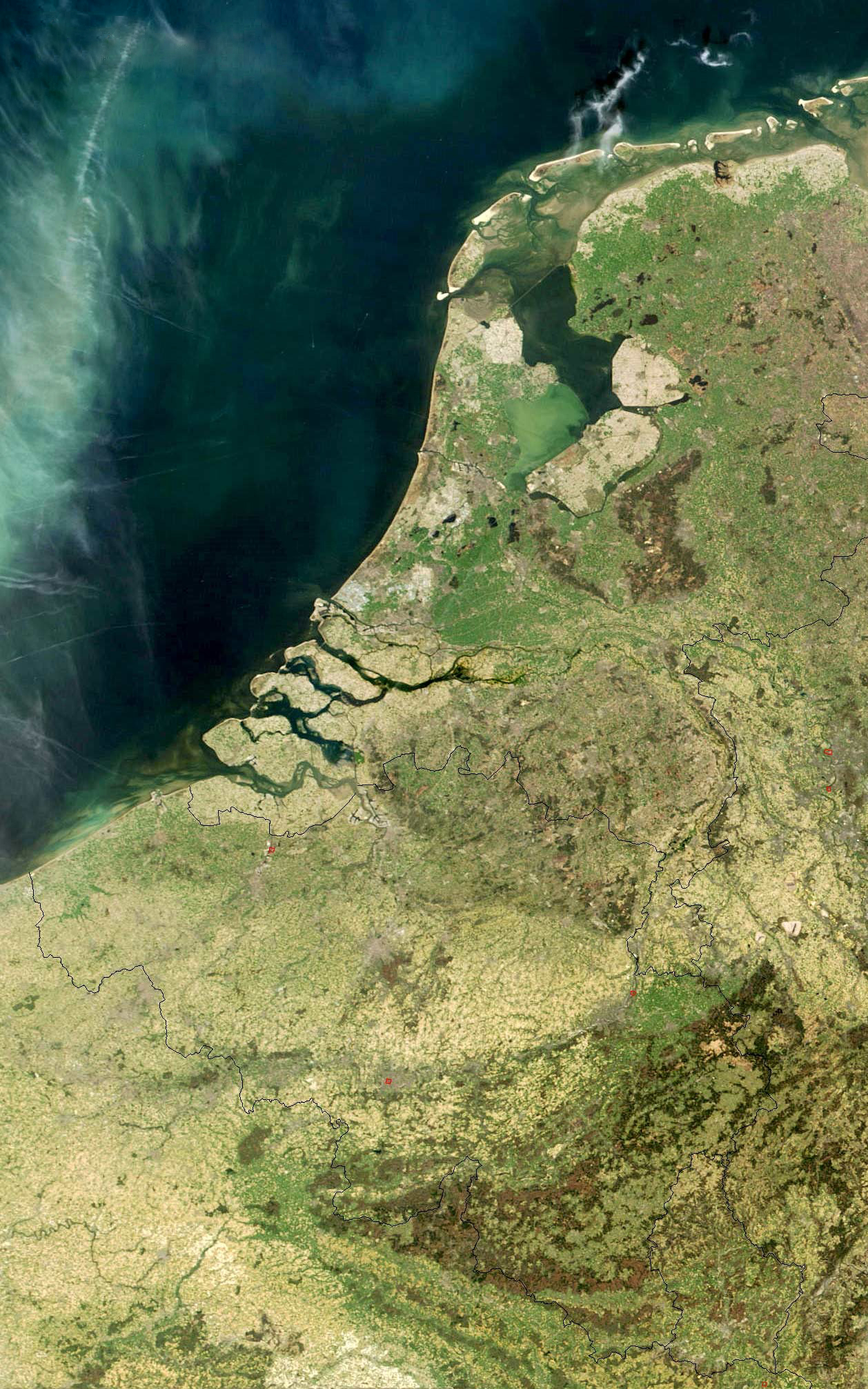|
Jacqueline, Countess Of Hainaut
Jacqueline (; ; ; 15 July 1401 – 8 October 1436), of the House of Wittelsbach, was a noblewoman who ruled the counties of Holland, Zeeland and Hainaut in the Low Countries from 1417 to 1433. She was also Dauphine of France for a short time between 1415 and 1417 and Duchess of Gloucester in the 1420s, if her marriage to Humphrey, Duke of Gloucester, is accepted as valid. Jacqueline was born in Le Quesnoy and from her birth she was referred to as "of Holland", indicating that she was the heiress of her father's estates. Jacqueline was the last Wittelsbach ruler of Hainaut and Holland. Following her death, her estates passed into the inheritance of Philip the Good, Duke of Burgundy. Life Early life and marriage to John, Duke of Touraine She was the only daughter of William II, Duke of Bavaria (also known as William VI, Count of Holland) from his marriage with Margaret, a daughter of Philip the Bold, Duke of Burgundy and Margaret III, Countess of Flanders. At the age of ... [...More Info...] [...Related Items...] OR: [Wikipedia] [Google] [Baidu] |
Van Eyck
Van Eyck or Van Eijk () is a Dutch language, Dutch toponymic surname. ''Eijck'', ''Eyck'', ''Eyk'' and ''Eijk'' are all archaic spellings of modern Dutch ("oak") and the surname literally translates as "from/of oak". However, in most cases, the family name refers to an origin in Maaseik. This city on the Meuse, now in Belgium on the border with the Netherlands, was originally simply known as ''Eike'' (with many spellings) and from the 13th century as Aldeneik, Old Eyck and Maaseik, New Eyck. Names with an affix (tussenvoegsel), like ''Van der Eijk'', are more likely to refer directly to the tree. at the Database of Surnames in The Netherlands. This article lists people with this surname. Renaissance family of painter ...
|
William II, Duke Of Bavaria
William II of Bavaria (5 April 1365—31 May 1417) was Duke of Bavaria-Straubing and count of Holland (listed as William VI), Hainaut (listed as William IV) and Zeeland. He ruled from 1404 until 1417, when he died from an infection caused by a dog bite. Biography William was a son of Albert I of Bavaria and Margaret of Brieg. William, allied with the Hooks, was in conflict with his father until 1394. In 1404 he succeeded him as count of Holland, Hainaut and Zeeland and duke of Bavaria-Straubing. In 1408 in the Battle of Othée, William, John the Fearless of Burgundy, and Louis VII of Bavaria defeated the citizens of Liège who had revolted against William's brother John, the bishop of Liège. As a result, he was no longer, as count of Hainaut, obliged to pay homage to the bishop. William's reign was marked by internal strife within the county of Holland. In particular, Lord John V of Arkel supported William's enemies in Holland. William conquered Arkel in 1412, ... [...More Info...] [...Related Items...] OR: [Wikipedia] [Google] [Baidu] |
Charles VI Of France
Charles VI (3 December 136821 October 1422), nicknamed the Beloved () and in the 19th century, the Mad ( or ''le Fou''), was King of France from 1380 until his death in 1422. He is known for his mental illness and psychosis, psychotic episodes that plagued him throughout his life. Charles ascended the throne at age 11, his father Charles V of France, Charles V leaving behind a favorable military situation, marked by the reconquest of most of the English possessions in France. Charles VI was placed under the regency of his uncles: Philip II, Duke of Burgundy; Louis I, Duke of Anjou; John, Duke of Berry; and Louis II, Duke of Bourbon. He decided in 1388, aged 20, to emancipate himself. In 1392, while leading a military expedition against the Duchy of Brittany, the king had his first attack of delirium, during which he attacked his own men in the forest of Le Mans. A few months later, following the ''Bal des Ardents'' (January 1393) where he narrowly escaped death from burning, Char ... [...More Info...] [...Related Items...] OR: [Wikipedia] [Google] [Baidu] |
John, Dauphin Of France (1398–1417)
John, Dauphin of France and Duke of Touraine (31 August 1398 – 5 April 1417) was Dauphin of Viennois and Duke of Touraine. He inherited the Dauphin of Viennois in 1415, following the death of his older brother, Louis. He died 5 April 1417, and was succeeded by his brother Charles. Early life John was born in 1398, the fourth son of Charles VI of France and Isabeau of Bavaria. At the age of four (in Paris on 5 May 1403) and again at the age of seven (in Compiègne on 29 June 1406), he was betrothed to Jacqueline, heiress of the County of Hainaut, Holland, Zealand, and Frisia. After his betrothal to Jacqueline, he was brought up alongside her at the castle of Le Quesnoy in Hainaut, at the court of his future mother-in-law, Margaret of Burgundy. This arrangement was made between his father and his future father-in-law to ensure his safety away from the tumultuous court in Paris, as well as to acquaint him with the lands which he would rule as husband of Jacqueline after her ... [...More Info...] [...Related Items...] OR: [Wikipedia] [Google] [Baidu] |
Compiègne
Compiègne (; ) is a Communes of France, commune in the Oise Departments of France, department of northern France. It is located on the river Oise (river), Oise, and its inhabitants are called ''Compiégnois'' (). Administration Compiègne is the seat of two canton in France, cantons: * Canton of Compiègne-1, Compiègne-1 (with 19 communes and part of Compiègne) * Canton of Compiègne-2, Compiègne-2 (with 16 communes and part of Compiègne) History by year * 665 - Saint Wilfrid was consecrated Bishop of York. Wilfrid refused to be consecrated in Northumbria at the hands of Anglo-Saxon bishops. Deusdedit of Canterbury, Deusdedit, Archbishop of Canterbury, had died, and as there were no other bishops in Britain whom Wilfrid considered to have been validly consecrated, he travelled to Compiègne, to be consecrated by Agilbert, the Bishop of Paris. * 757 - Byzantine emperor Constantine V sent to Compiègne a gift for Pepin the Short : France's first organ. * 833 - Louis the Pious ... [...More Info...] [...Related Items...] OR: [Wikipedia] [Google] [Baidu] |
Margaret III Of Flanders
Margaret III (13 April 1350 – 16/21 March 1405) was a ruling Countess of Flanders, Countess of Artois, and Countess of Auvergne and Boulogne between 1384 and 1405. She was the last ruler of Flanders of the House of Dampierre. She was also Duchess of Burgundy by marriage to Philip I, Duke of Burgundy, Philip I and Philip II of Burgundy. Biography Margaret was the only surviving child and heir of Count Louis II of Flanders (1346–1384) and Margaret of Brabant, Countess of Flanders, Margaret of Brabant. First marriage In 1355, Margaret of Flanders married Philip I, Duke of Burgundy, Philip of Rouvres, grandson and heir of Odo IV, Duke of Burgundy. Philip was Count of Burgundy and Count of Artois, Artois (1347–1361), Duke of Burgundy (1350–1361), and became Rulers of Auvergne, Count of Auvergne and count of Boulogne, Boulogne (1360–1361). Second marriage Following Philip's death from a riding accident in 1361, Margaret was widowed and had no issue b ... [...More Info...] [...Related Items...] OR: [Wikipedia] [Google] [Baidu] |
Philip The Bold
Philip II the Bold (; ; 17 January 1342 – 27 April 1404) was Duke of Burgundy and ''jure uxoris'' Count of Flanders, Artois and Burgundy. He was the fourth and youngest son of King John II of France and Bonne of Luxembourg. Philip was the founder of the Burgundian branch of the House of Valois. His vast collection of territories made him the undisputed premier peer of the Kingdom of France and made his successors formidable subjects, and later rivals, of the kings of France. Philip played an important role in the development of gunpowder artillery in European warfare, making extensive and successful use of it in his military campaigns. By political marriage, from 1384 Philip gained control over Flanders, one of the most wealthy provinces of Europe in that time. He and his successors ruled it until 1482. This period is referred to as the Burgundian Netherlands. Early life Philip was born in Pontoise in 1342 to John and Bonne of Luxembourg. His father, John, was the ... [...More Info...] [...Related Items...] OR: [Wikipedia] [Google] [Baidu] |
Duke Of Burgundy
Duke of Burgundy () was a title used by the rulers of the Duchy of Burgundy, from its establishment in 843 to its annexation by the Crown lands of France, French crown in 1477, and later by members of the House of Habsburg, including Holy Roman Emperors and kings of Spain, who claimed Burgundy proper and ruled the Burgundian Netherlands. The Duchy of Burgundy was a small portion of the traditional lands of the Burgundians west of the river Saône which, in 843, was allotted to Charles the Bald's kingdom of the West Franks. Under the Ancien Régime, the duke of Burgundy was the premier lay Peerage of France, peer of the Kingdom of France. Beginning with Robert II of France (), the title was held by the Capetians, the French royal family. In 1032 King Henry I of France granted the duchy to his younger brother, Robert I, Duke of Burgundy, Robert, who founded the House of Burgundy. When the senior line of the House of Burgundy became extinct in 1361, the title was inherited by King Jo ... [...More Info...] [...Related Items...] OR: [Wikipedia] [Google] [Baidu] |
Duchess Of Gloucester
Duchess of Gloucester is the principal Courtesy titles in the United Kingdom, courtesy title used by the wife of the Duke of Gloucester. There have been five titles referring to Gloucester since the 14th century. The current duchess is Birgitte, Duchess of Gloucester, Birgitte, the wife of Prince Richard, Duke of Gloucester, Prince Richard. He inherited the dukedom on 10 June 1974 upon the death of his father, Prince Henry, Duke of Gloucester, Prince Henry, the third son of George V. History When Thomas of Woodstock, Duke of Gloucester, Thomas of Woodstock, youngest son of Edward III of England, Edward III and Philippa of Hainault, was created duke of Gloucester around 1385, his wife Eleanor de Bohun, daughter of Humphrey de Bohun, 7th Earl of Hereford, and Joan Fitzalan, Countess of Hereford, Joan Fitzalan, became duchess of Gloucester. Thomas was stripped of his dukedom after being declared guilty of treason in 1397. Their son Humphrey, 2nd Earl of Buckingham, did not inherit ... [...More Info...] [...Related Items...] OR: [Wikipedia] [Google] [Baidu] |
Dauphine Of France
The dauphine of France (, also , ) was the wife of the dauphin of France (the heir apparent to the French throne). The position was analogous to a crown princess (the wife of a crown prince and heir apparent to a throne). List of dauphines of France House of Valois House of Bourbon See also * Dauphine of Auvergne * List of Angevin consorts * Countesses and Duchesses of Maine * List of consorts of Alençon Countess of Alençon House of Bellême, ?–? House of Capet, 1269–1284 House of Valois, 1291–1414/5 Duchess of Alençon First Creation Second Creation *Francis, Duke of Anjou, None Third Creation Fourth Creati ... * List of consorts of Bourbon * List of consorts of Vendôme * Countess of Artois * Countess of Provence * List of consorts of Lorraine * Princess of Condé * List of consorts of Montpensier * List of consorts of Conti * List of consorts of Étampes * Countess of Évreux * Countess of Champagne * List of consor ... [...More Info...] [...Related Items...] OR: [Wikipedia] [Google] [Baidu] |
Low Countries
The Low Countries (; ), historically also known as the Netherlands (), is a coastal lowland region in Northwestern Europe forming the lower Drainage basin, basin of the Rhine–Meuse–Scheldt delta and consisting today of the three modern "Benelux" countries: Belgium, Luxembourg, and the Netherlands (, which is singular). Geographically and historically, the area can also include parts of France (such as Nord (French department), Nord and Pas-de-Calais) and the Germany, German regions of East Frisia, Geldern, Guelders and Cleves. During the Middle Ages, the Low Countries were divided into numerous semi-independent principalities. Historically, the regions without access to the sea linked themselves politically and economically to those with access to form various unions of ports and hinterland, stretching inland as far as parts of the German Rhineland. Because of this, nowadays not only physically low-altitude areas, but also some hilly or elevated regions are considered part of ... [...More Info...] [...Related Items...] OR: [Wikipedia] [Google] [Baidu] |
County Of Hainaut
The County of Hainaut ( ; ; ; ), sometimes spelled Hainault, was a territorial lordship within the medieval Holy Roman Empire that straddled the present-day border of Belgium and France. Its most important towns included Mons, Belgium, Mons (), now in Belgium, and Valenciennes, now in France. The core of the county, named after the river Haine, stretched southeast to include the ''Avesnois'' region and southwest to the Selle (Scheldt tributary). In the Middle Ages, its Counts also gained control of part of the original Pagus of Brabant, ''pagus'' of Brabant to its north and the ''pagus'' of Oosterbant to the east, but they did not form part of the old ''pagus'' of Hainaut. In modern terms, the original core of Hainaut consisted of the central part of the Belgian province of Hainaut (province) , Hainaut, and the eastern part of the French ''département'' of Nord (département) , Nord (the Arrondissements of France, arrondissements of Arrondissement of Avesnes-sur-Helpe, Avesnes ... [...More Info...] [...Related Items...] OR: [Wikipedia] [Google] [Baidu] |






